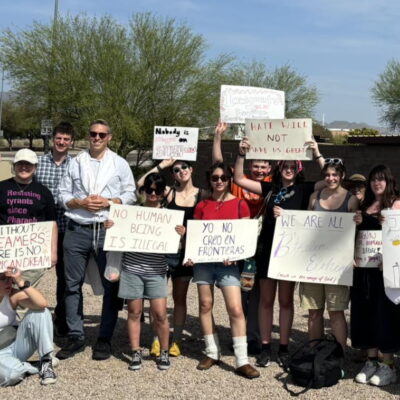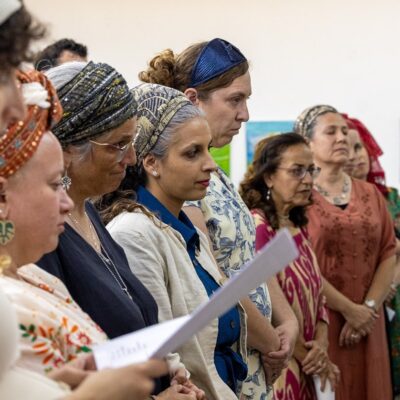Opinion
Strategic Planning Can Help Congregations and Its Leaders to Thrive

By Robert Leventhal and Aimee Close
As part of USCJ’s Kehilla Strengthening and Transformation Department, we have the privilege of working every day with the dedicated leadership of USCJ congregations across North America. Over the course of doing this work, we have noticed several common characteristics among synagogues that are thriving in the current environment. Even in our most highly sophisticated and successful congregations, however, there were certain attributes that remained less developed.
In a 2016 study of 20 of our largest and best resourced congregations, we found that out of 22 attributes of thriving congregations we had identified, there were several attributes that seemed to be under-developed in these large congregations. While these seemingly successful congregations scored high on attributes related to being caring and inclusive, commitment to social justice and to Israel, and providing engaging learning experiences, they scored much lower in other areas:
- Shared Vision – The congregation has a compelling vision of engaged, dynamic and authentic Jewish living.
- Integrated Communications – They use their website, social media, and signage to communicate the message.
- Clear Expectations and Accountability – Both staff and volunteers understand what is expected and are held accountable.
- Reflective and Learning Leadership – Leadership engages in reflective practices.
- Sustainable Lay Leadership – They have developed a plan to build and maintain leadership capacity.
- Strategic Focus – There are strategic goals that guide the work of lay and professional leadership.
- Collaborative and Constructive Culture – Collaborations and partnerships are used throughout the organization.
- Leadership Transparency – The community understands how and why decisions are made.
- Financial Sustainability Plan – There is a plan in place and it has been shared it with the community.
In our strategic planning work with congregations, our goal is to create a strategic plan that can be adopted and implemented by the board. A secondary goal is to increase the leadership capacity of those directly engaged in the process. Here are some examples of how the strategic planning process can help develop thriving leaders, not just thriving congregations:
Thriving leaders have strategic focus. Before beginning the planning process, we require planners to send a letter to their executive committee, outlining the goals of the process and requesting the Board’s approval, a step that is often omitted by ad hoc planning groups. In addition, congregations must send two planning leaders to our New York office for training. We have found that when congregations have tried to omit this step, they tend to have a difficult time getting started.
The President of the congregation recruits the planning chairs and gets the commitment of the senior staff, and then the chairs recruit the rest of the steering committee. We view the steering committee as a committee of the board tasked with making recommendations. In this way, we teach planners what it means to be empowered by, and accountable to, the board.
Thriving leaders create clear expectations for staff and lay leadership. We teach leaders to empower the staff to bring their expertise to the planning process. The rabbi’s commitment is essential and we ask the rabbi to take a leadership role in ensuring staff participation. We also ask them to be a senior partner in creating a compelling vision. The process models strategic work as a partnership between staff and lay leaders.
Thriving congregations create a continuous pipeline of leaders. A recent USCJ survey showed that many congregations have difficulty recruiting new leaders, and often have nobody willing to become president. We feel strongly that innovation is sparked by the interaction between committed, core members who have experience and commitment to the synagogue, and fresh, new leaders who bring new ideas, people and energy. Our goal is to teach leaders how to welcome new ideas and the people to drive them.
Thriving leaders are reflective. We encourage congregations to take the time to get to the root cause of a problem, and not simply address symptoms. Through a multipronged approach to data gathering, we teach leaders to develop a set of shared facts and assumptions, and not rush to implications and solutions.
A SWOT analysis is a process of listing the strengths and weaknesses of an organization, and the opportunities and threats facing it. We see the SWOT analysis as an iterative process. We do an initial SWOT as a team building exercise early in the process, after they have begun the data collection process. In this way, we help planning leaders understand that strategic planning is an iterative process, and that often, the solution to a complex problem only emerges after several rounds of discussion.
Thriving leaders want to increase transparency about how decisions are made. We welcome the participation of the congregation at key points in the process. All members are invited to complete the congregational survey and participate in a Community Conversation or Town Hall meeting. We use these meetings to invite members to participate in discussions dedicated to strategic focus areas (e.g. membership, ritual, education, finance). Some of the participants may be recruited to join task forces. In convening these larger meetings, we teach planning leaders to obtain greater involvement and engagement of the larger membership.
Thriving leaders create compelling mission and vision statements. The word compelling suggests passion and energy. We teach leaders to use mission-oriented questions to welcome fresh mission language from steering committee members and staff. We engage the board and the steering committee in a visioning process to brainstorm a rich, detailed portrait of what each area of congregational life would look like if they were successful, and how they can build on their strengths to create the future they envision. By engaging in this vision process, planning leaders learn how to build a shared vision, and help their team work toward that vision.
Thriving leaders use integrated communication to communicate the vision. If the congregation has compelling mission and vision language, it is important that people hear about it in the rabbi’s sermons, on the website, on social media, in bulletin articles, and out in the broader community. With an integrated communication plan, messages reinforces one another.
Thriving leaders expand the circle of planners and welcome an ever-growing number of voices and conversations. We have found that many synagogue leaders tend to want to go directly from visioning to concrete problem solving. We discourage this, and instead encourage them to develop bold strategic statements that provide a strategic framework to the task forces to inspire them as they begin their work.
Thriving leaders have strategic focus. When the task forces have completed their work and submitted their reports to the steering committee, we convene a meeting of the steering committee and the task force chairs. The entire group reviews the recommendations together, and in a facilitated exercise, they come to a consensus on the top priorities, based on what they think will have the most significant impact on the congregation over the next several years. They also have an honest discussion about their capacity to do the work. We help planning leaders to understand that they have limited capacity, and that they need to prioritize what can be done and set reasonable timelines for completion.
Thriving leaders have a commitment to ongoing reflection and continuous improvement. We have found that most congregational boards are not careful readers of plans, nor do they fully understand what is required to implement those plans. Planning is not linear, and a strategic plan does not necessarily provide a step by step blueprint for implementation. Most will require additional leadership reflection and conversation throughout the implementation process. So, part of what we teach is that the learning process does not end with the approval of the plan, but is fluid and ongoing.
It is our experience that a well-designed strategic planning process can ensure that the impact of the process extends beyond the implementation of the plan. Such a process should build leadership capacity and make it more likely that current and future plans will be successful. In other words, a good strategic planning process can, and should, change the leadership culture of a congregation.
For more information about USCJ’s Sulam for Strategic Planners program, contact Bob Leventhal at USCJ.
Aimee Close is a USCJ Transformation Specialist, who works with congregations across North America in the areas of strategic planning and leadership development. She lives and works in the Greater Boston area.
Bob Leventhal is USCJ’s Transformation Team Leader. Over the past 17 years, Bob has worked with hundreds of congregations, previously as a consultant for the Alban Institute and currently, as a staff member at USCJ, and has written extensively about synagogue leadership and long-range planning.













